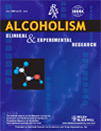Classical eyeblink conditioning (EBC) involves contingent temporal pairing of a conditioned stimulus (e.g., tone) with an unconditioned stimulus (e.g., air puff). Impairment of EBC has been demonstrated in studies of alcohol-exposed animals and in children exposed prenatally at heavy levels.
Fetal alcohol syndrome (FAS) was diagnosed by expert dysmorphologists in a large sample of Cape Coloured, South African children. Delay EBC was examined in a new sample of 63 children at 11.3 years, and trace conditioning in 32 of the same children at 12.8 years. At each age, 2 sessions of 50 trials each were administered on the same day; 2 more sessions the next day, for children not meeting criterion for conditioning.
Six of 34 (17.6%) children born to heavy drinkers were diagnosed with FAS, 28 were heavily exposed nonsyndromal (HE), and 29 were nonexposed controls. Only 33.3% with FAS and 42.9% of HE met criterion for delay conditioning, compared with 79.3% of controls. The more difficult trace conditioning task was also highly sensitive to fetal alcohol exposure. Only 16.7% of the FAS and 21.4% of HE met criterion for trace conditioning, compared with 66.7% of controls.
The magnitude of the effect of diagnostic group on trace conditioning was not greater than the effect on short delay conditioning, findings consistent with recent rat studies. Longer latency to onset and peak eyeblink CR in exposed children indicated poor timing and failure to blink in anticipation of the puff. Extended training resulted in some but not all of the children reaching criterion.
The magnitude of the effect of diagnostic group on trace conditioning was not greater than the effect on short delay conditioning, findings consistent with recent rat studies. Longer latency to onset and peak eyeblink CR in exposed children indicated poor timing and failure to blink in anticipation of the puff. Extended training resulted in some but not all of the children reaching criterion.
These data showing alcohol-related delay and trace conditioning deficits extend our earlier findings of impaired EBC in 5-year-olds to school-age. Alcohol-related impairment in the cerebellar circuitry required for both forms of conditioning may be sufficient to account for the deficit in both tasks. Extended training was beneficial for some exposed children. EBC provides a well-characterized model system for assessment of degree of cerebellar-related learning and memory dysfunction in fetal alcohol exposed children.
Read Full Abstract
Request Reprint E-Mail: sandra.jacobson@wayne.edu
Read Full Abstract
Request Reprint E-Mail: sandra.jacobson@wayne.edu
